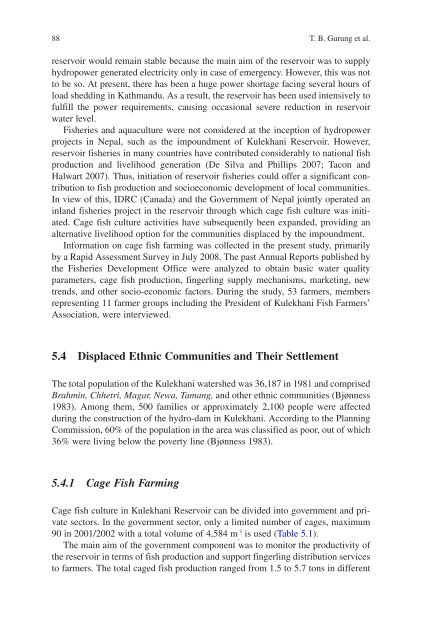Success Stories In Asian Aquaculture - Library - Network of ...
Success Stories In Asian Aquaculture - Library - Network of ...
Success Stories In Asian Aquaculture - Library - Network of ...
- No tags were found...
You also want an ePaper? Increase the reach of your titles
YUMPU automatically turns print PDFs into web optimized ePapers that Google loves.
88 T. B. Gurung et al.reservoir would remain stable because the main aim <strong>of</strong> the reservoir was to supplyhydropower generated electricity only in case <strong>of</strong> emergency. However, this was notto be so. At present, there has been a huge power shortage facing several hours <strong>of</strong>load shedding in Kathmandu. As a result, the reservoir has been used intensively t<strong>of</strong>ulfill the power requirements, causing occasional severe reduction in reservoirwater level.Fisheries and aquaculture were not considered at the inception <strong>of</strong> hydropowerprojects in Nepal, such as the impoundment <strong>of</strong> Kulekhani Reservoir. However,reservoir fisheries in many countries have contributed considerably to national fishproduction and livelihood generation (De Silva and Phillips 2007 ; Tacon andHalwart 2007) . Thus, initiation <strong>of</strong> reservoir fisheries could <strong>of</strong>fer a significant contributionto fish production and socioeconomic development <strong>of</strong> local communities.<strong>In</strong> view <strong>of</strong> this, IDRC (Canada) and the Government <strong>of</strong> Nepal jointly operated aninland fisheries project in the reservoir through which cage fish culture was initiated.Cage fish culture activities have subsequently been expanded, providing analternative livelihood option for the communities displaced by the impoundment.<strong>In</strong>formation on cage fish farming was collected in the present study, primarilyby a Rapid Assessment Survey in July 2008. The past Annual Reports published bythe Fisheries Development Office were analyzed to obtain basic water qualityparameters, cage fish production, fingerling supply mechanisms, marketing, newtrends, and other socio-economic factors. During the study, 53 farmers, membersrepresenting 11 farmer groups including the President <strong>of</strong> Kulekhani Fish Farmers’Association, were interviewed.5.4 Displaced Ethnic Communities and Their SettlementThe total population <strong>of</strong> the Kulekhani watershed was 36,187 in 1981 and comprisedBrahmin, Chhetri, Magar, Newa, Tamang, and other ethnic communities (Bjønness1983) . Among them, 500 families or approximately 2,100 people were affectedduring the construction <strong>of</strong> the hydro-dam in Kulekhani. According to the PlanningCommission, 60% <strong>of</strong> the population in the area was classified as poor, out <strong>of</strong> which36% were living below the poverty line (Bjønness 1983) .5.4.1 Cage Fish FarmingCage fish culture in Kulekhani Reservoir can be divided into government and privatesectors. <strong>In</strong> the government sector, only a limited number <strong>of</strong> cages, maximum90 in 2001/2002 with a total volume <strong>of</strong> 4,584 m , 3 is used (Table 5.1 ).The main aim <strong>of</strong> the government component was to monitor the productivity <strong>of</strong>the reservoir in terms <strong>of</strong> fish production and support fingerling distribution servicesto farmers. The total caged fish production ranged from 1.5 to 5.7 tons in different
















